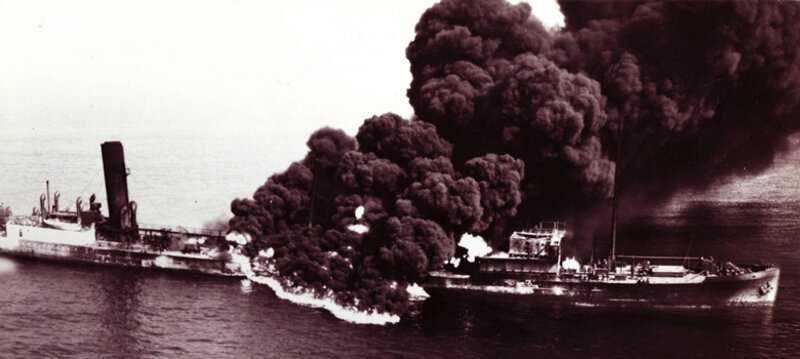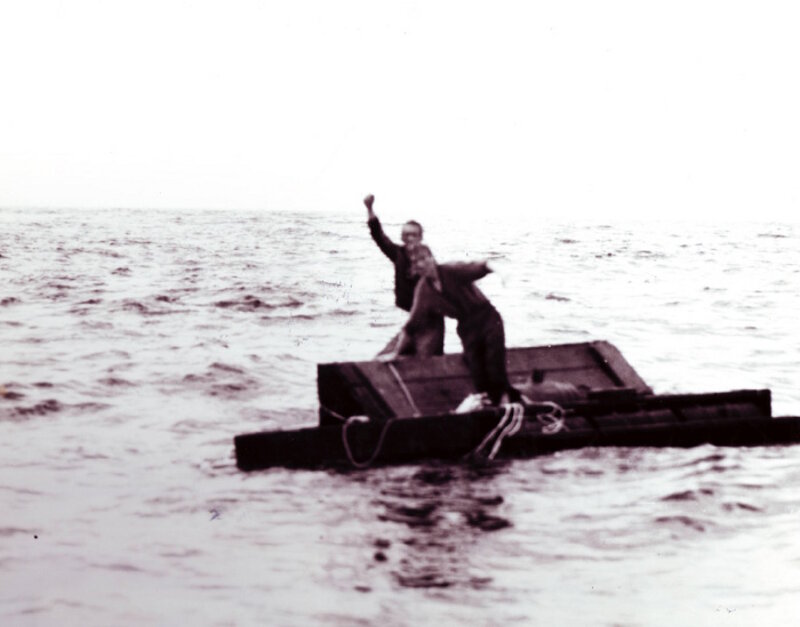
Joe Hoyt, Maritime Archaeologist - NOAA Office of National Marine Sanctuaries

Torpedoed tanker Byron Benson burns off North Carolina’s coast after a U-boat attack. Image courtesy of NARA. Download larger version (jpg, 271 KB).
“… the only thing that ever really frightened me during the war was the U-boat peril” – Winston Churchill (Second World War, Vol. 2)
The Battle of the Atlantic began mere hours after Britain declared war on Germany in September 1939, and would last until Germany’s surrender in May 1945. This extensive naval engagement between Allied, Axis, and neutral forces constituted the longest single operation of World War II (WWII), and was the longest, largest, and most complex naval battle in history (Syrett 1994). Civilians, sailors, soldiers, marines, and coastguardsmen engaged in combat, and in turn gave their lives, in a dire struggle for seapower in the Atlantic.

Survivors from torpedoed ship Chenango cling to wreckage off North Carolina. Image courtesy of NARA. Download larger version (jpg, 146 KB).
Retired Royal Navy escort group commander, Donald MacIntyre (1961), wrote of the battle‘s importance to the entire Allied war effort:
“[as] an aspect of naval warfare, which on account of its often hum-drum nature is apt to be looked upon as a side-show, a back-water of the main stream of naval operations, yet which is in fact the whole purpose of seapower and in which an island power must either decisively win or be driven to abject surrender.”
He could not have been more correct. The flow of war materials into Great Britain via the Atlantic was the lifeline of the Allied war effort against Germany, and Germany nearly severed it. Though the Battle of the Atlantic was not witness to spectacular fleet engagements like those fought in the Pacific, it was nonetheless of supreme strategic importance. At stake was the last bastion of resistance in Europe to Hitler’s dreadful war machine.
German Admiral Karl Doenitz correctly identified the western Atlantic as the weakest segment in the supply system that kept Great Britain fighting.
“U-boat warfare is a fight against enemy merchant tonnage… The use of boats in the American area is right according to this standpoint of economic deployment… America is the largest enemy ship builder. The shipbuilding industry area lies in the eastern states and it, and the industries connected with it, relies considerably on oil fuel… For each tanker which is shot up the Americans loose not only the oil transport but it effects their new construction adversely. Therefore the sinking of this American transport tonnage seems to me especially important.” (Admiral Karl Doesnitz, Befehlshaber der Unterseeboote 1942:28-29).
Doenitz was acutely aware of the strategic conditions along the eastern seaboard of the United States. It would take the Americans some time to organize convoys, build ships, and be able to effectively combat U-boats in their waters, so the decision was made to exploit these weaknesses. Doenitz was also aware time was crucial as these circumstances were unlikely to persist, stating it was of primary importance to “take full advantage of the favorable situation as quickly as possible and with all available forces, before the anticipated changes occurred” (Doenitz 1959:196).
When the U-boats arrived off the east coast of America, they were overwhelmed by the sight the American coast presented them. America did not appear to be at war, ships continued to cruise about unescorted, fully lighted and starkly silhouetted by city lights. By staying submerged during the day and coming to the surface at night, the U-boats were able to cruise the sea-lanes of America unhindered, laying mines and torpedoing vessels as they went (Botting 1979:130; Freeman 1987:27).
In a campaign known to the Germans as “The American Shooting Season,” the U-boats “enjoyed for a time a veritable Eldorado, and their successes rose to undreamed-of figures—in six-and-a-half months, over 2,500,000 tons… Targets were so plentiful that it was more often lack of torpedoes than shortage of fuel which compelled the U-boats to turn for home” (Busch 1955:40-45).
The initial wave of U-boats deployed in Operation Paukenschlag consisted of just six vessels deployed between December 16 and 25 1941, arriving off the East Coast in mid-January 1942. This is far fewer than Doenitz had hoped. So it was, that with a small number of U-boats on this first foray, enormous successes were achieved. Following America’s entry into WWII, German U-boat raiders attacked merchant shipping off the United States’ east coast with astonishing success. What ensued came to be known as the ‘American turkey shoot,’ with nearly 200 merchant vessels sunk between January and April of 1942 (Cheatham 1990).
This was inaugurated by Germany‘s initial offensive, code named Operation Paukenschlag, or ‘Operation Drumbeat.’ This “Atlantic Pearl Harbor” was the prelude to nearly five months of unchecked German commerce raiding on the East Coast (Gannon 1990). Slowly, though, combined Allied naval forces resisted and ultimately forced the withdrawal of German forces haunting American waters.
Hard fought, yet far from over by the end of 1942, the Battle of the Atlantic all but left the eastern shores of the United States. The loss of U-576 on July 15 of 1942 marked a final symptom in the decline of U-boat effectiveness on the East Coast.